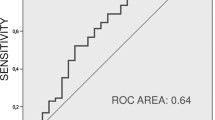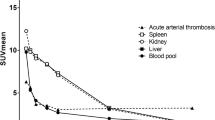Abstract
Aim
Detection of acute deep venous thrombosis (DVT) in patients presenting with clinical symptoms suggesting DVT and pulmonary embolism (PE) with 99mTc-apcitide, a synthetic polypeptide, binding to glycoprotein IIb/IIIa receptors expressed on activated platelets is the objective of the study.
Materials and methods
Nineteen patients (11 males, eight females) received within 24h after admission to the hospital a mean of 841MBq (range 667 to 1,080) 99mTc-apcitide i.v. followed by planar recordings 10, 60, and 120min after injection. Images were compared to the results of compression ultrasonography and/or phlebography. Patients with clinically suspected PE underwent spiral computed tomography or lung perfusion scans.
Results
99mTc-apcitide scintigraphy showed acute clot formation in 14 out of 16 patients where the other imaging modalities suggested DVT. Positive scintigraphic results were seen up to 17days after the onset of clinical symptoms. In three out of three patients without any proof of DVT, 99mTc-apcitide scintigraphy was truly negative. Glycoprotein receptor imaging showed only one segmental PE in six patients with imaging-proven subsegmental (N = 3) or segmental PE (N = 3).
Conclusion
99mTc-apcitide scintigraphy may be an easy and promising tool for the detection of acute clot formation in patients with DVT up to 17days after the onset of clinical symptoms with a sensitivity of 87% and a specificity of 100%. However, it failed to demonstrate PE in 83% of examined patients with proven PE.


Similar content being viewed by others
References
Segal JB, Eng J, Tamariz LJ, Bass EB. Review of the evidence on diagnosis of deep venous thrombosis and pulmonary embolism. Ann Fam Med 2007;5:63–73.
Moser KM LeMoine J. Is embolic risk conditioned by location of deep venous thrombosis? Ann Intern Med 1981;94:439–44.
Hull RD, Carter CJ, Jay RM, Ockelford PA, Hirsch J, Turpie AG, et al. The diagnosis of acute, recurrent, deep vein thrombosis: a diagnostic challenge. Circulation 1983;67:901–6.
Wells RD, Hirsh J, Anderson DR, Lensing AW, Foster G, Kearon C, et al. Accuracy of clinical assessment of deep-vein thrombosis. Lancet 1995;345:1326–30.
Stamatakis JD, Kaddar VW, Lawrence D, Bentley PG. The origin of thrombi in the deep veins of the lower limb: a venographic study. Br J Radiol 1978;65:449–51.
Hull RD, Hirsh J, Carter CJ, Jay RM, Dodd PE, Ockelford PA, et al. Pulmonary angiography, ventilation lung scanning, and venography for clinically suspected pulmonary embolism with abnormal perfusion lung scan. Ann Intern Med 1983;98:891–9.
Cronan JJ. Venous thromboembolic disease: the role of ultrasound. Radiology 1993;186:1619–50.
Lensing AWA, Hirsh J, Büller HR. Diagnosis of venous thrombosis. In: Coleman RW, Hirsh J, Marder VJ, Salzman EW, editors. Hemostasis and thrombosis: basic principles and clinical practice. 3rd ed. Philadelphia, PA: JB Lippincott; 1994. p. 1297–302.
Heijboer H, Jongbloets LM, Buller HR, Lensing AW, ten Cate JW. Clinical utility of real-time compression ultrasonography for diagnostic management of patients with recurrent venous thrombosis. Acta Radiol 1992;33:297–300.
Muto P, Lastoria S, Varella P, Vergara E, Salvatore M, Morgano G, et al. Detecting deep venous thrombosis with 99mTc-labeled synthetic peptide P280. J Nucl Med 1995;36:1384–91.
Muto P, Lastoria S, Varrella P. Thrombus imaging with a technetium-99m-labeled, activated platelet receptor binding peptide. J Nucl Med 1996;37:775–81.
Taillefer R, Thérasse E, Turpin S, Lambert R, Robillard P, Soulez G. Comparison of early and delayed scintigraphy with 99mTc-apcitide and correlation with contrast-enhanced venography in detection of acute vein thrombosis. J Nucl Med 1999;40:2029–35.
Taillefer R, Edell S, Innes G, Lister-James J. Acute thromboscintigraphy with 99mTc-apcitide: results of a phase 3 multicenter clinical trial comparing 99mTc-apcitide scintigraphy with contrast venography for imaging acute DVT. J Nucl Med 2000;41:1214–23.
Davison JM, Bridwell R, Montilla JL, Jackson E, Moores LK. A novel diagnostic method for acute pulmonary embolism: technetium-99m apcitide scintigraphy. Ann Intern Med 2004;140:936–9.
Freiman DG. The structure of thrombi. In: Coleman R, Hirsh J, Marder V, Salzman EW, editors. Hemostasis and thrombosis: basic principles and clinical practice. 2nd ed. Philadelphia, PA: JB Lippincott; 1987. p. 1123–35.
Abdollahi M, Cushman M, Rosendaal FR. Obesity: risk of venous thrombosis and the interaction with coagulation factor levels and oral contraceptive use. Thromb Haemost 2003;89:493–8.
Dahlborn M, Ahlborg G, Söderborg B, Virgin J, Wilczek B. Gamma camera detection of 99mTc-plasmin in the diagnosis of deep-vein thrombosis. Eur J Nucl Med 1984;9:499–501.
Tengborn L, Hedner U. Demonstration of 99mTc-labelled plasmin and a2-antiplasmin on the surface of ex vivo thrombi. In: Davidson JF, editor. Progress in fibrinolysis, vol 5. Edinburgh, UK: Churchill Livingstone; 1981. p. 324–8.
Anand S, Wells PS, Brilll-Edwards P, Cook D, Ginsburg JS. Does this patient have deep vein thrombosis? JAMA 1998;279:1094–9.
Ginsberg JS, Hirsh J, Rainbow AJ, Coates G. Risks to the fetus of radiologic procedures used in the diagnosis of maternal venous thromboembolic disease. Thromb Haemost 1989;61:189–96.
Rose SC, Zwiebel WJ, Nelson BD, Priest DL, Knighton RA, Brown JW, et al. Symptomatic lower extremity deep venous thrombosis: accuracy, limitations, and role of color duplex flow imaging in diagnosis. Radiology 1990;175:639–44.
Davidson B, Elliot C, Lensing A. Low accuracy of color Doppler ultrasound in the detection of proximal leg vein thrombosis in asymptomatic high risk patients: the RD heparin arthroplasty group. Ann Intern Med 1992;117:735–8.
Lensing A, Pradoni P, Brandjes D, Huisman PM, Vigo M, Tomasella G, Krekt J, Wouter Ten Cate J, Huisman MV, Büller HR. Detection of deep-vein thrombosis by real time B-mode ultrasonography. N Engl J Med 1989;320:342–5.
Author information
Authors and Affiliations
Corresponding author
Rights and permissions
About this article
Cite this article
Dunzinger, A., Hafner, F., Schaffler, G. et al. 99mTc-apcitide scintigraphy in patients with clinically suspected deep venous thrombosis and pulmonary embolism. Eur J Nucl Med Mol Imaging 35, 2082–2087 (2008). https://doi.org/10.1007/s00259-008-0863-5
Received:
Accepted:
Published:
Issue Date:
DOI: https://doi.org/10.1007/s00259-008-0863-5




